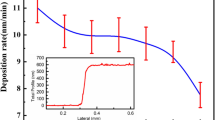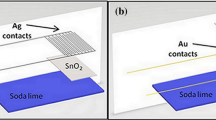Abstract
The utilization of amorphous germanium-tin (Ge1-xSnx) semiconducting thin films as temperature-sensing layers in microbolometers was recently presented and patented. The work in this paper was performed as an extension of the latest study to acquire better Sn concentrations % for microbolometer applications. In this work, Ge1-xSnx thin films with various Sn concentrations %, x, where 0.31 ≤ x ≤ 0.48, were sputter-deposited. The elemental composition of each film was evaluated using energy-dispersive X-ray (EDX) spectroscopy, and the surface morphology was evaluated using atomic force microscopy (AFM), showing average roughness values between ~ 0.2 and 0.8 nm. Measurements of the sheet resistance versus temperature were performed and analyzed, revealing temperature coefficients of resistance, TCRs, ranging from –3.11%/K to –2.52%/K for x ranging from 0.31 to 0.40 above which the Ge1-xSnx thin film was found to exhibit metallic behavior at 0.40 < x ≤ 0.48. Empirical relationships relating the resistivity, TCR, and Sn concentration % of the amorphous Ge1-xSnx thin films were derived. One of the films with a 31% Sn concentration (Ge0.69Sn0.31) was used to fabricate 10×10 μm2 microbolometer prototypes using electron-beam lithography and lift-off techniques, and the microbolometer was fabricated on top of oxidized silicon substrates with no air gap between them. The noise behavior and the maximum detected signal of the fabricated microbolometer were measured. The signal-to-noise ratio, voltage responsivity, and noise equivalent power values of the prototypes were calculated. Finally, the expected performance of a proposed air-bridge microbolometer configuration was calculated.








Similar content being viewed by others
Data Availability
The datasets generated during and/or analyzed during the current study are available from the corresponding author on reasonable request.
References
Niklaus F, Vieider C, Jakobsen H. MEMS-based uncooled infrared bolometer arrays: a review. In: Chiao J-C, Chen X, Zhou Z, Li X, editors. MEMS/MOEMS Technol. Appl. III, vol. 6836, 2007, p. 68360D. https://doi.org/10.1117/12.755128.
P.W. Kruse, Uncooled Thermal Imaging Arrays, Systems, and Applications, SPIE, Washington, 2002.
Rogalski A. Infrared Detectors, 2nd and. CRC Press, Taylor & Francis Group, LLC, 2010.
Xue X, Xiong H, Song Z, Du Y, Wu D, Pan L, et al. Silicon Diode Uncooled FPA With Three-Dimensional Integrated CMOS Readout Circuits. IEEE Sensors J 2019;19:426–34. https://doi.org/10.1109/JSEN.2018.2878098.
Abdel-Rahman M, Zia M, Alduraibi M. Temperature-Dependent Resistive Properties of Vanadium Pentoxide/Vanadium Multi-Layer Thin Films for Microbolometer & Antenna-Coupled Microbolometer Applications. Sensors 2019;19:1320. https://doi.org/10.3390/s19061320.
Jae-Kwan Kim, Chul-Hi Han. A new uncooled thermal IR detector using silicon diode. Proc. IEEE Thirteen. Annu. Int. Conf. Micro Electro Mech. Syst. (Cat. No.00CH36308), IEEE; 2002, p. 102–7. https://doi.org/10.1109/MEMSYS.2000.838498.
Celik O, Duman M. High temperature coefficient of resistance and low noise tungsten oxide doped amorphous vanadium oxide thin films for microbolometer applications. Thin Solid Films 2019;691:137590. https://doi.org/10.1016/j.tsf.2019.137590.
Zhou XF, Zhang H, Yan H, He CL, Lu MH, Hao RY. Giant temperature coefficient of resistance in Co-doped ZnO thin films. Appl Phys A Mater Sci Process 2014;114:809–12. https://doi.org/10.1007/s00339-013-7665-8.
Ambrosio R, Moreno M, Mireles J, Torres A, Kosarev A, Heredia A. An overview of uncooled infrared sensors technology based on amorphous silicon and silicon germanium alloys. Phys Status Solidi 2010;7:1180–1183. https://doi.org/10.1002/pssc.200982781.
Abdel-Rahman M, Ilahi S, Zia MF, Alduraibi M, Debbar N, Yacoubi N, et al. Temperature coefficient of resistance and thermal conductivity of Vanadium oxide ‘Big Mac’ sandwich structure. Infrared Phys Technol 2015;71:127–30. https://doi.org/10.1016/j.infrared.2015.03.006.
Tissot JL, Robert P, Durand A, Durand S, Durand E, Crastes A. Status of Uncooled Infrared Detector Technology at ULIS, France, Def Sci J 2013;63:545–9. https://doi.org/10.14429/dsj.63.5753.
Jaime Damiany Carddona. Germanium tin oxide thin films for uncooled infrared detectors. Delaware State University, 2019.
Yu L, Guo Y, Zhu H, Luo M, Han P, Ji X. Low-Cost Microbolometer Type Infrared Detectors. Micromachines 2020;11:800. https://doi.org/10.3390/mi11090800.
Jimenez R, Moreno M, Torres A, Morales A, Ponce A, Ferrusca D, et al. Fabrication of Microbolometer Arrays Based on Polymorphous Silicon-Germanium. Sensors (Basel) 2020;20:2716. https://doi.org/10.3390/s20092716.
Abdel-Rahman M, Alduraibi M, Hezam M, Ilahi B. Sputter deposited GeSn alloy: A candidate material for temperature sensing layers in uncooled microbolometers. Infrared Phys Technol 2019;97:376–80. https://doi.org/10.1016/j.infrared.2019.01.023.
Mohamed Ramy Abdel-Rahman; Mohammad Abdulaziz Alduraibi; Bouraoui, Ilahi B. Thermal Sensing Layer for Microbolometer and Method of Making The Same, 2010.
Wood RA. Chapter 3 Monolithic Silicon Microbolometer Arrays. Semicond. Semimetals, vol. 47, Plymouth Minnesota: 1997, p. 43-121d. https://doi.org/10.1016/S0080-8784(08)62689-7.
Zia MF, Abdel-Rahman M, Alduraibi M, Ilahi B, Awad E, Majzoub S. Electrical and Infrared Optical Properties of Vanadium Oxide Semiconducting Thin-Film Thermometers. J Electron Mater 2017;46:5978–85. https://doi.org/10.1007/s11664-017-5571-0.
Syllaios AJ, Schimert TR, Gooch RW, McCardel WL, Ritchey BA, Tregilgas JH. Amorphous Silicon Microbolometer Technology. MRS Proc 2000;609:A14.4. https://doi.org/10.1557/PROC-609-A14.4.
Abdel-Rahman M, Al-Khalli N, Zia MF, Alduraibi M, Ilahi B, Awad E, et al. Fabrication and design of vanadium oxide microbolometer. vol. 020001, AIP; 2017, p. 020001. https://doi.org/10.1063/1.4975416.
Acknowledgment
The authors extend their appreciation to the Deputyship for Research & Innovation, Ministry of Education in Saudi Arabia for funding this research work through the project no. (IFKSURG-2-478).
Funding
This study was funded by the Deputyship for Research and Innovation, Ministry of Education in Saudi Arabia through the project no. IFKSURG-2-478.
Author information
Authors and Affiliations
Contributions
Esam Bahaidra: conceptualization, data curation, formal analysis, and writing, original draft
Najeeb Al-Khalli: data curation, formal analysis, investigation, and visualization
Mahmoud Hezam: prepared Figs. 1 and -2 and formal analysis (supporting)
Mohammad Alduraibi: supervision and writing, review and editing
B. Ilahi: prepared Fig. 7 and formal analysis (supporting)
Nacer Debbar: supervision and writing, review and editing
Mohamed Abdel-Rahman: supervision and writing, review and editing
Corresponding author
Ethics declarations
Ethical Approval
Not applicable
Competing Interests
The authors declare no competing interests.
Additional information
Publisher’s Note
Springer Nature remains neutral with regard to jurisdictional claims in published maps and institutional affiliations.
Rights and permissions
Springer Nature or its licensor (e.g. a society or other partner) holds exclusive rights to this article under a publishing agreement with the author(s) or other rightsholder(s); author self-archiving of the accepted manuscript version of this article is solely governed by the terms of such publishing agreement and applicable law.
About this article
Cite this article
Bahaidra, E., Al-Khalli, N., Hezam, M. et al. Electro-Optical Characterization of an Amorphous Germanium-Tin (Ge1-XSnx) Microbolometer. J Infrared Milli Terahz Waves 44, 233–244 (2023). https://doi.org/10.1007/s10762-023-00909-2
Received:
Accepted:
Published:
Issue Date:
DOI: https://doi.org/10.1007/s10762-023-00909-2




